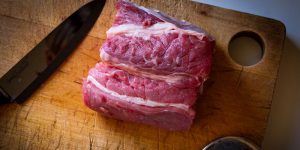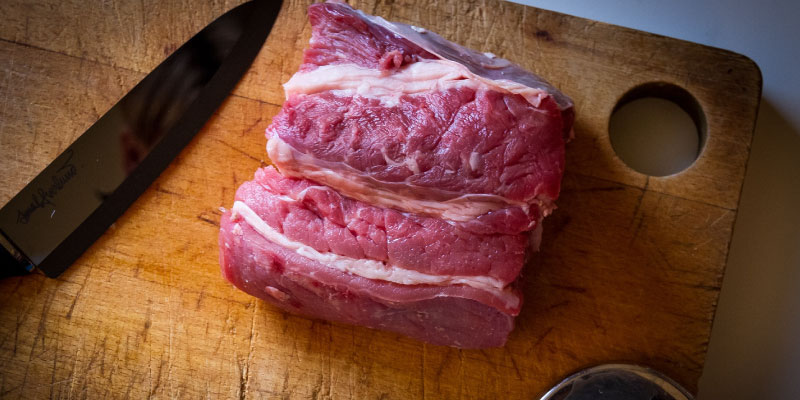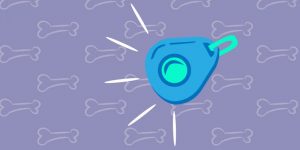If you’re wondering whether you should switch between regular dog food and the raw food diet, then you’ve come to the right place. We take a look at the ups and down of this food trend.
We all want what’s best for our dog. When it comes to giving them the best, one of the most contentious issues is what to feed our dogs. Some people may prefer a certain brand of food while others prefer dry over wet or cooked over raw.

One such trend that is picking up in popularity is the raw diet for dogs. This doesn’t mean restricting your dog to a lifetime of crunchy vegetables – it’s actually very balanced and could provide many health benefits. However, you need to be aware of the dangers before switching your dog to a raw food diet.
Raw dog food for beginners
The raw food diet came to prominence in the early 90s when it was seen as a healthy alternative for racing greyhounds and sled dogs.
Popularised by Australian veterinarian Ian Billinghurst, the BARF diet – otherwise known as Bones and Raw Food or Biologically Appropriate Raw Food – is based on the theory that dogs thrive with ‘evolutionary food’.
Similar to humans taking on a ‘paleo’ diet, the idea is that dogs go back to eating what they ate before they were domesticated. This means raw bones and plant scraps are totally natural to a dog, and are therefore what will suit them best.
Why nutritionists dislike cooked dog food
Likewise, there is also the theory that cooking dog food removes some of the essential nutrients.
Some nutritionists claim that exposing dog food to high temperatures kills essential enzymes and fatty acids, and in extreme cases, can even turn them into ‘poisons’ by causing unnatural bonds between proteins and starches. The theory here is that much of the food becomes indigestible, leading to stomach upsets.
Another issue that some dog nutritionists have with dog food is the way in which it’s bulked up. Dog kibble and other additives may be high in stodgy carbohydrates, leaving less room for essential nutrients.
This results in a cheaper, more convenient product, but may not be the best food for your dog. Of course, that said, there is lots of good high quality dog food in market, both as kibble and cooked.
But generally, if you are looking for a raw food diet, chances are, you’ve tried a few and they’ve come up short.
What does the raw food diet for dogs include?
When prepared appropriately, safe raw dog food items include:
- Meat from the muscle, usually on the bone in its most natural form
- Ground or whole bones
- Occasional organ meats e.g. liver/kidneys
- Apples and other crunchy fruits
- Fish (raw salmon for dogs is just as yummy and popular as it is for humans!)
- Green vegetables high in iron like spinach and broccoli
- Raw eggs
- Occasional dairy, like yoghurt (some dogs may be intolerant to dairy)
Just don’t forget that not all human food around the home is dog friendly. Some, like grapes, onions and potatoes, are generally to be avoided at all costs.
What do I need to know before I switch my dog’s diet?
There are many dog raw diet benefits, which may convince you to make the transition. You may notice shinier coats and healthier skin, while your dog’s teeth will also be cleaner without having to resort to dental toys.
The benefits of a raw food diet for dogs extend to you, too. You might notice improved energy levels, great for when you’re running around the park, and smaller stools. It’s a small change that could have a huge impact on your life.
Healthy, but is it easy?
Yes and no. Lime most things in life, it depends on how much you are ready to spend.
You can buy ready made raw food packs, which can be on the more expensive side, but with very little effort. It can easily cost double or triple the amount of standard kibble.
However, it doesn’t have to cost the moon, if you are willing to to the research and make the food yourself. However, this requires preparation and can be very time consuming. Which isn’t easy.
Are there any dangers to a raw food diet in dogs?
As with any big change to your dog’s life, introducing new dog food does have its dangers and shouldn’t be taken lightly. This is a high risk choice and many veterans associations have specifically spoken out against it. In short, if you are going to do this, read the dangers of the raw food diet carefully, and then ensure you take appropriate steps to minimise the danger.
Salmonella, Listeria, E.coli. Oh My.
The biggest concern is the preparation and storage of raw meat.
If you do not buy high-quality meat, or if you serve it beyond its expiration date, you could be exposing both you and your dog to harmful bacteria or even worms.
Just like it’s always a little dangerous buying supermarket sushi and safer to go to a high a sushi restaurant, make sure you get the best and freshest cuts. This goes for bones and eggs too, not just meat.
Ensuring a well-balanced diet
Your dog’s diet also needs to be balanced. Many pre-mixed dog foods offer the nutritional benefits of fruit and vegetables as they’re fortified with vitamins and minerals.
Despite the idea that dogs are small wolves in disguise, dogs are actually omnivores, not carnivores. If you feed your dog meat and meat alone, it may suffer from a lack of nutrients.
This, more than anything, is the reason why Vet’s don’t generally recommend the Raw Food Dog diet. They just don’t trust that owners will be able to ensure they account for every vitamin and mineral.
But you know what you can get if you are really worried? Healthy and natural dog supplements.
What kind of bones can you give your dog?
Finally, there are also the dangers around eating bones to consider. This is where the ‘raw’ of the raw food diet comes into play.
You need to make sure your dog isn’t exposed to any sharp edges, as this could cause internal bleeding. Sharp edges are created by the cooking of bones. Never, ever, give you dog cooked bones.
Unlike the old wife’s tale, chicken isn’t all bad. The uncooked bony parts of chicken, such as necks, wings, and backs will be loved and chewed happily by your pup. Turkey necks, beef knuckles, marrow bones, and lamb bones are all also great choices.
How you incorporate these into your diet will depend on what you are looking to achieve. Poultry bonus mentioned above are soft enough to be digested, whilst harder bonus (ie. Beef, Lamb, Buffalo) will either need to be ground up or use as ‘recreational bones’.
In short, they should be chewed under supervision, for 10 or 15 minutes, and then put back in the fridge to avoid bacteria build up. Hard bones rarely last for longer than 3 days.
How can I make my own homemade raw dog food?
If you have time, the best raw dog food is food that has been prepared yourself. You can make easy homemade raw dog food by mixing up some of the above mentioned ingredients to produce a tasty, balanced meal.
Here’s a great recipe to get you started. It includes a little bit of everything and is emulsified with ingredients you can find in your kitchen cupboard. Start with:
- Ground beef (At least 30%)
- Livers (chicken is easiest about 10%. If using other organs, this can be increased to up to 30% depending on the amount of beef, but never more than 10% of liver meat due to it’s richness)
- Carrots, cored apples and spinach (Somewhere around 20%)
- Eggs and bones (calcium is important – keep the shell and this should be about 10% to 20% of the meal)
- Plain yoghurt (for added calcium and taste)
- Flaxseed (to bind)
- Olive oil (to bind)
You can vary the amounts depending on the size of your dog. Generally speaking, your dog’s meal should weigh no more than 2% of its body weight.
Start by blending the vegetables together in a food processor. Add everything else except the beef and mix well.
Once it’s formed a fine paste, add the beef and mix together. Form the mixture into patties as one single serving each.
You can also freeze these patties – just take them out and let them defrost in the fridge for 24 hours before serving.
What about raw dog treats?
You can usually find these pre-packaged, from fruits to dried meats. Just ensure that there are no bulking ingredients or other unnatural additives.
The packaging should state that it is free of all GM or otherwise non-organic ingredients.
What’s the side effects of changing dog food?
Bear in mind that changing your dog food may produce some unwanted side effects in the short-term. Always consult your vet if you’re not sure, especially if you’r pooch has been sensitive in the past.
When switching over to a raw food diet, you may notice:
- Excess gas
- Vomiting
- Diarrhoea
However, this is most common if you transition your dog over to raw food too quickly. You should introduce the changes slowly, by adding maybe 10% with raw food, and keep adding 10% over the course of a week.
What you are doing here is gradually weaning your dog off its previous diet. Consider smaller servings, too – meals with a high nutrition density may feel heavier for your dog.
Don’t forget, pets spend years eating the same foods, so their bodies are not as used to change as ours.
That said, in the Raw food diet, dogs may find themselves to be surprisingly flexible to a variety of meats and vegetables. Feel free to experiments with beef trachea, tails, lungs, chicken feet, offals and pizzles.
Cheap, and doggy delicious.
So, is the raw food dog diet for me?
Only you can decide what’s best for your dog, but many nutritionists agree that what is natural is best for our pets. There are downsides to a raw dog food diet – for example, as an owner you may find that it’s more expensive and more time-consuming to prepare these foods.
More importantly, if you don’t commit to this diet properly you may make your pup ill rather than healthier.
However, when prepared properly, you should see myriad benefits in your dog. Keep an eye on your dog’s day to day behaviour. Monitor how they looks, for example the shine its coat, and take a note to see if its breath changes. It’s usually for the best.
Other developments may include smaller, firmer stools and more energy when you’re out for walkies.
Finally, only make the change if you can commit to a raw food diet. The worst thing you want is to make your dog used to one thing only to change it suddenly.
Always ask your vet if you’re not sure, and if your pup is really struggling, it may be best to stick to what he/she is eating now. All dogs are different, and their reactions may differ based on age or breed.
As the old saying goes… Mama/Papa knows best!




